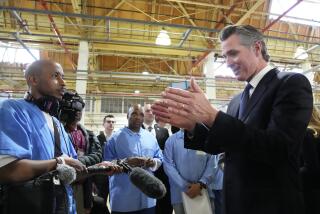California prison overcrowding case heads to Supreme Court
- Share via
Reporting from Washington and Los Angeles — The suicide rate in California’s overcrowded prisons is nearly twice the national average, and one inmate dies every eight days from inadequate medical care.
These are just two indicators cited in the 15-year legal battle over whether the state’s prisons are failing to provide humane medical care for the 165,000 inmates.
On Tuesday, the problems of California’s prisons will move to a national stage when the Supreme Court hears the state’s challenge to an extraordinary court order that would require the prison population to be reduced by about 25% in two years. That could mean releasing or transferring more than 40,000 inmates, state lawyers say.
The case is not just of interest to California.
Lawyers for 18 other states, including Illinois, Pennsylvania and Virginia, joined in support of California’s appeal, saying they feared a ruling upholding the prison release order could trigger similar moves across the nation. “Real world experience” suggests that releasing a large number of inmates would “inevitably place innocent citizens at much greater risk,” they said.
Gov. Arnold Schwarzenegger and other state officials call the order from a panel of three federal judges “the most sweeping intrusion into a state’s management” of its prisons ever handed down by a court. They say the panel — composed of two federal district judges and a federal appeals judge — is “using the guise of providing healthcare” to order a restructuring of the state’s correctional system. They also argue that the forced release of prisoners would threaten public safety.
Defenders of the judges’ order cite Schwarzenegger’s own words in 2006 declaring that California faced an overcrowding emergency in its prisons. They also say the state is exaggerating the possible effect of the order. California locks up many prisoners for repeat petty crimes or for technical parole violations, even though they are not considered dangerous or violent.
“California has people in prison who wouldn’t be in prison in any other state,” said former George W. Bush administration Solicitor Gen. Paul D. Clement, who represents one group of state prisoners. His brief cites comments from a former Texas prison director who said he was surprised and disturbed by the overcrowding in California’s prisons.
Supporters of the judges’ order also emphasize that it does not require a wholesale release of inmates. For example, the prisons could free up space by relocating some inmates to county jails, private prisons or out-of-state facilities. In addition, some nonviolent inmates could be released early.
“We’re sending 80,000 people to prison each year for two to three months — parole violators who are going from their home communities to sit in reception centers where there is no rehabilitation, no healthcare, no drug programs,” said Michael Bien, lead attorney in the case brought on behalf of prisoners deprived of mental healthcare.
“This is the kind of thing that everyone knows doesn’t do anything for public safety,” Bien added. “These men and women come back home after a couple of months having been exposed to much more dangerous people. If they weren’t dangerous before, they are now.”
The case began in the early 1990s with separate lawsuits contending that inmates who were mentally ill or had chronic health problems were suffering behind bars. The 8th Amendment forbids cruel and unusual punishment, and it has been read to mean prisoners cannot be denied needed medical care.
U.S. District Judges Lawrence Karlton in Sacramento and Thelton Henderson in San Francisco separately ruled that the prisoners were suffering from unconstitutional ill treatment, and they handed down at least 80 orders requiring state prisons to make improvements. Despite promises from prison authorities, the state did not comply with most of the orders.
Frustrated, the judges called for convening a three-judge panel under the terms of a federal law that authorizes prison releases as a last resort. The chief judge of the U.S. 9th Circuit Court of Appeals appointed Judge Stephen Reinhardt from that court to sit on the panel with Karlton and Henderson.
The panel then determined that overcrowding was the “primary cause” of the substandard medical care, and on Aug. 4, 2009, ordered the state to reduce the prison population to 137.5% of the original design capacity in its 33 prisons, or about 40,000 fewer inmates than they now hold.
In June, the Supreme Court agreed to hear Schwarzenegger’s appeal.
Most legal experts assume the conservative justices of the high court will cast a skeptical eye on the prison release order, especially because the three judges from California have long liberal records. In a friend-of-the-court brief, Kent Scheidegger of the Criminal Justice Legal Foundation, a law-and-order group in Sacramento, called the choice of Reinhardt “astonishing” and said it was reason enough for the high court to set aside the release order.
But Robert Weisberg, a professor of criminal justice at Stanford University, said the court should focus on the long record in the case.
“I hope this will be looked at as a lawsuit on appeal and not a political Armageddon,” he said.
More to Read
Sign up for Essential California
The most important California stories and recommendations in your inbox every morning.
You may occasionally receive promotional content from the Los Angeles Times.















